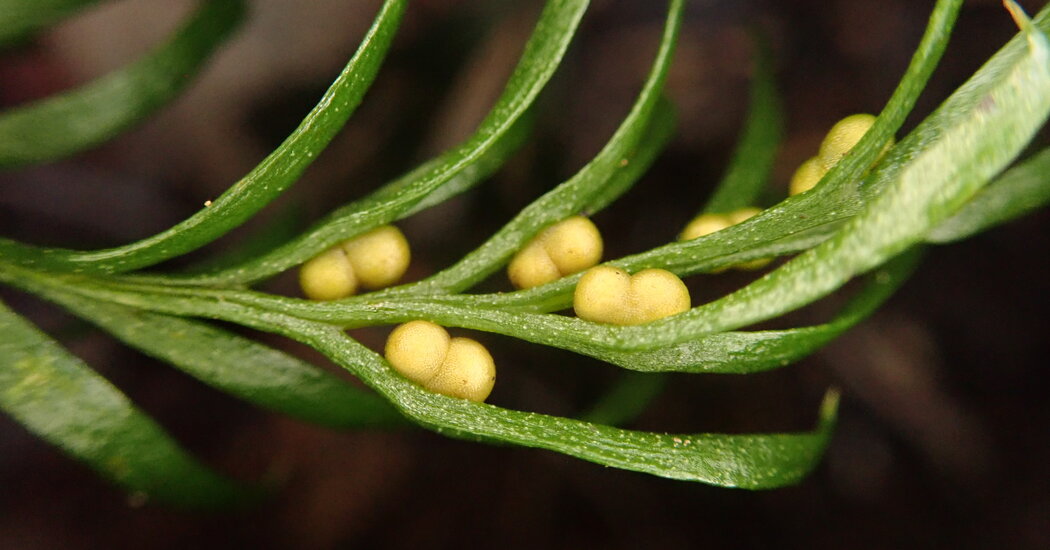Last year, Jaume Pellicer led a team of fellow scientists into the forest on Grande Terre, an island east of Australia. They were looking for a fern called Tmesipteris oblanceolata. Only a few centimeters tall, it was not easy to find on the forest floor.
«It doesn’t stand out,» said Dr. Pellicer, who works at the Botanical Institute in Barcelona, Spain. «You’d probably step on it without even realizing it.»
Scientists eventually managed to spot an inconspicuous fern. When Dr. Pellicer and his colleagues studied it in the laboratory, they discovered that it was hiding an incredible secret. Tmesipteris oblanceolata has the largest known genome on Earth. As researchers described in a study published Friday, fern cells contain more than 50 times more DNA than our own.
If you find it strange that such a humble plant has such a huge genome, scientists think so too. The enigma emerged in the 1950s, when biologists discovered that the double helix of DNA encodes genes. Each gene consists of a series of genetic letters, and our cells read these letters to produce the appropriate proteins.
Scientists hypothesized that humans and other complex species must produce many different proteins and therefore have larger genomes. But when they weighed the DNA in different animals, they found that they were very wrong. Frogs, salamanders and lungfish had much larger genomes than humans.
It turns out that genomes are much stranger than scientists expected. For example, we carry about 20,000 protein-coding genes, but they make up only 1.5 percent of the 3 billion pairs of letters in our genome.
Another nine percent is made up of parts of DNA that don’t code for proteins, but still perform important jobs. Some of them, for example, act like switches to turn neighboring genes on and off.
The other 90 percent of the human genome has no known function. Some scientists have a gentle nickname for this vast amount of mysterious DNA: junk.
Some species have little junk DNA, while others have staggering amounts. The African lungfish, for example, has about the same number of protein-coding genes as we do, but they are scattered across a giant genome totaling 40 billion pairs of DNA letters—13 times more DNA than our own genome contains.
In the early 2000s, when Dr. Pellicer was training to become a botanist, he was intrigued to learn that several plant lineages also had huge genomes. Onions, for example, have a genome five times larger than ours.
In 2010, when Dr. Pellicer started working at Kew Gardens in London, he was given the opportunity to study a family of plants known as buds, which were known to have large genomes. He spent months shredding leaves with a blade, isolating cells from dozens of species and weighing their DNA.
When he weighed the genome of the plant Paris japonica, which grows in the mountains near Nagano, Japan, he was shocked by the result. An ordinary flower had a genome containing 148 billion pairs of letters – a world record.
In the years that followed, colleagues sent him fresh samples of ferns from Australia and New Zealand to chop. He discovered that these plants also have a huge genome, although not as big as that of Paris Japonica.
dr. Pellicer knew that related species of ferns grew on several Pacific islands. In 2016, he began making plans for an expedition to Grande Terre, part of the archipelago known as New Caledonia.
He finally arrived on the island only in 2023. He collected numerous species together with a team that included colleagues from Kew, his student Pol Fernández and local plant experts.
In Barcelona, Mr. Fernández was surprised to discover that the genome of Tmesipteris oblanceolata contains about 160 billion pairs of DNA letters. Thirteen years after Dr. Pellicer discovered the record-breaking genome, his student was also experiencing the thrill of breaking records.
There are two main ways that genomes spread over evolutionary time. Many species carry parts of DNA similar to viruses. As they make new copies of their genomes, they sometimes accidentally make an extra copy of that viral part. Over many generations, a species can accumulate thousands of new copies, causing its genome to swell.
It is also possible for a species to suddenly gain two genomes instead of one. One way in which an extra genome can arise is when two closely related species mate. Their hybrid offspring can inherit full sets of DNA from both parents.
dr. Pellicer and his colleagues suspect that a combination of virus-like DNA and duplicated genomes is responsible for the vast amount of genetic material in Tmesipteris oblanceolata. But they don’t know why this humble fern ended up with a record-setting genome, while other species – like us – have much less DNA.
It is possible that most species gradually accumulate DNA in their genomes without any harm. «A lot of biology is ‘why not?’ but ‘why?'» said Julie Blommaert, a genomicist at New Zealand’s Plant and Food Research Institute who was not involved in the new study.
Eventually, however, genomes can become so large that they become a burden. The cells may have to expand to accommodate all the extra DNA. They also need more time and more nutrients to make new copies of their giant genomes. An organism with too large a genome may lose to a rival with a smaller one. So evolution can favor mutations that cut out unnecessary DNA.
It is possible that animals and plants can develop truly giant genomes only in special environments, such as stable climates where there is no competition. «Maybe that’s why they’re so rare — they steal them because they’re not effective,» Dr. Pellicer said.
Even in the coziest home, genomes cannot grow to infinite sizes. In fact, Dr. Pellicer suspects that Tmesipteris oblanceolata may have reached a physical genome limit. «I believe we are close,» he said.
Others are not so sure.
«I don’t know if we’ve hit the ceiling yet,» said Brittany Sutherland, a botanist at George Mason University who was not involved in the study. She noted that botanists have measured genome sizes in only 12,000 plant species, leaving 400,000 other species to study. «What we have estimates for is the last straw,» she said.



